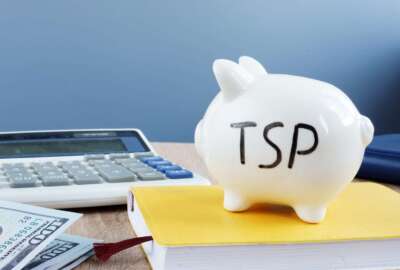How to make sure you outlive your investments after you retire
No one avoids death and taxes. But you can make sure an element that is crucial to a comfortable retirement lasts the rest of your life.
No one avoids death and taxes. But you can make sure an element — that is crucial to a comfortable retirement — lasts the rest of your life. For what it is and how to preserve it, the Federal Drive with Tom Temin talked with certified financial planner Art Stein of Arthur Stein Financial.
Interview Transcript:
Tom Temin All right, give us the big story. What needs to last the rest of your life?
Art Stein Tom, federal retirees or, you know, let’s talk about FERS retirees. They have two sources of income during retirement. And one, of course, is guaranteed income. And guaranteed income is Social Security and their FERS annuity. And those are great. They’re guaranteed to last the rest of their life. And they both have cost of living adjustments. But most FERS retirees at some time during their retirement are going to have to start taking money from their investments to supplement their guaranteed income, and that’s something that may happen to them. You know, as soon as they retire, it may be 5 or 10 years into retirement. Of course, one problem for FERS retirees is that any time inflation is more than 2%, the purchasing power of their annuity declines. And for most FERS retirees are going to have to make that up by taking money from their investments.
Tom Temin But the investment presumably it’s a TSP. I mean, you’ve got to make the minimum withdrawal at some point.
Art Stein Yeah, absolutely. But you don’t have to spend it. You can reinvest it, you know, after you pay the taxes.
Tom Temin Got it.
Art Stein So it means that they never have to worry about running out of money because they’ll always have the guaranteed income. What they need to worry about is running out of investments. And that’s when being too conservative over a long period of time can really hasten the day that people run out of investments. Because the G fund, which is, you know, the most popular fund and even the F fund pretty much guaranteed to lose purchasing power once you take into account taxes and inflation. And that’s also true of bank accounts. And lots of federal employees and retirees have very significant amounts and bank accounts. And those lose purchasing power over time too. So let me just give you a really simple example. And the simplest example is going to be about bank accounts. Let’s say you’re going to give a party in 12 months. A couple is going to give a party in 12 months. And they estimate the cost of the party to be $1,000. So, they want to be very prudent. So, they take $1,000 and invest it in a bank account, money market fund. It’s considered 100% safe, guaranteed by the federal government. And it does not fluctuate in value. So, if they leave it in there for 12 months and they earn 2% simple interest, at the end of 12 months, I’ll have $1,020. Now they have to pay tax on the interest. They paid $6 in tax. They’d have $1,014 left. So, it sounds pretty good. They had $1,000 party. Now they have 1014. But we forgot to take into account inflation. Inflation’s only 3%. The thousand-dollar party is now costing $1,030. They only have $1,014 after taxes. So, they’re $16 short. They lost purchasing power after taxes and inflation. Now clearly in this example not a big deal. It’s only $16. It only compounds over, you know one year. But many retirees have heard and read that when they’re retired, and even as they approach retirement, they should have the majority of their money in bonds and bank accounts, which for the TSP means the G fund in the F fund. And for most TSP participants, it mainly means the G fund because they don’t like the F funds. So yeah.
Tom Temin That’s the preaching of safety. In other words, above all else.
Art Stein Preaching safety above all else. And that’s because those types of investments, when we say they’re safer, that’s very misleading, Tom. What they are is less volatile. And volatility is not the only investment risk. And really, for long term investors, the most important retirement risk is taxes and inflation reducing the purchasing power of their investments. It’s very difficult because people put their money in the G fund, and they see it gradually increase in value and they don’t think about, well, is it keeping up with taxes and inflation. And many people, you know, really, when they judge the amount of money they have, if they look at the amount in the TSP and say, I have $1 million in the TSP, I’ve got $1 million to spend. Well, of course that’s not true. It’s $1 million minus taxes, so it’s a much lower amount.
Tom Temin We’re speaking with certified planner Art Stein of Arthur Stein Financial. I guess I’m still trying to get my mind around the idea of $1,000 party. I guess in today’s inflation, that means a case of Budweiser. And four of your best friends at this point.
Art Stein What other kind of party is there?
Tom Temin That’s right. But if you take that million versus 1000, and you take your calculations out for 20, 25, 30 years, it’s tens or hundreds of thousands of dollars you might be forgoing in intrinsic value of your investments. That will never be.
Art Stein Absolutely. You know, I can tell you that, you know, with the cost-of-living adjustment for FERS retirees, if inflation were 3% a year, they’re only going to get a 2% per year inflation adjustment after ten years. That would reduce the purchasing power, their annuity 8%. After 20 years, you would reduce at 17%. They’re going to have to make up that difference.
Tom Temin So you really have to look at your future life and retirement, not so much from how many dollars are sitting in the different accounts, but what those accounts are doing and also what you actually need to maintain your lifestyle.
Art Stein Yes. And that’s what you know, retirement planning is all about, is looking, well, how much do I have? What kind of rate of return can I expect based upon, you know, what funds I’m invested in and how much do I expect to spend in retirement? And this is where, again, I think a lot of people make a mistake. How long a retirement do I need to plan for? Now, none of us know how long we’re going to live, but if we’re healthy now and say we retire at 65, people need to assume that they’re going to have a 30-year retirement, at least because many of us are going to live that long. And, you know, ten years from now, medical care is going to be much better than it is now. And same thing, true 20 and 30 years from now. Medical system, it’s great at keeping us alive. And it means that we could live a very long time and be very healthy. And a lot of people don’t think of it that way. I mean, I just spoke to a couple of yesterday and the wife is 82, and, you know, I was explaining this, and she said, well, you know, I’m 82. How long a retirement do I need to plan for? And I said, well, how’s your health? She said, well, I got some vision problems on there and that I’m 100% healthy. How long did your parents live while their mom lived to 92? Well, her mother died 20 years ago. If her mother could live to 92 with the medical care they had 20 years ago, why couldn’t she live another 10 or 15 years?
Tom Temin And just a practical question. Some people feel they need, and they do need, people need liquid assets. You might want to pay cash for a car or vacation or something, and that would not be in your TSP, because you don’t want to try to withdraw the principal if you can avoid that. What is a good way to keep cash? Or let’s say not so much cash, but a liquid asset that you can turn to cash quickly because you have a legitimate call for it.
Art Stein Yeah, absolutely. Everybody should have an emergency fund, which is not a great name for that, because it sounds like something bad happened, a new car and need to pay for a wedding for my son or daughter, or I want to get money to my grandkids. And you know, banks are great for that. But you also want to make sure you don’t have too much in low yielding bank accounts. I mean, if you look around in today’s world, you can find online bank accounts that are paying five, 5.25%. But many people are letting money just sit in their local bank account and getting a quarter of a percent, a half, a percent, 1%. That’s a big loss.
Tom Temin Then with respect to your TSP distributions. You can always change the distribution if you want to. You may not get that 25 years’ worth of better growth, but you can get better growth while you’re at it.
Art Stein Yeah. And money, you know, you expect to take out and spend in the next 3 or 4 years. I mean, the G fund is a good place for that. And the F fund in most normal years is also a good place for that. The stock funds C, S and I, the money that’s in there is money that you would need ten, 20, 30 years from now because stocks are much more volatile than bonds. But over long periods of time, historically, stocks have outperformed bonds by enough to make it worthwhile to put up with the bad years.
Tom Temin Good advice for making sure you can have that $1030 party, certified planner. Art Stein of Arthur Stein Financial. As always, thank you so much.
Art Stein Thank you Tom.
Tom Temin We’ll post this interview at Federal news network.com/Federal Drive. Subscribe to the federal drive wherever you get your podcasts.
Copyright © 2025 Federal News Network. All rights reserved. This website is not intended for users located within the European Economic Area.
Tom Temin is host of the Federal Drive and has been providing insight on federal technology and management issues for more than 30 years.
Follow @tteminWFED






